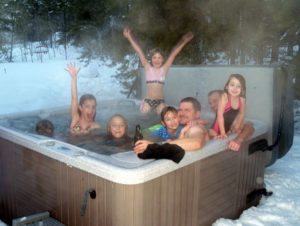 One of the top reasons people love their spas is because it is so soothing and therapeutic to soak in warm water.
One of the top reasons people love their spas is because it is so soothing and therapeutic to soak in warm water.
The spa water heats as it is circulated through the plumbing system and passes the heater. A spa heater generally operates at a temperature that is a few degrees above the temperature of the water. For instance, if the spa’s thermostat is set at 102 degrees, the heater element will be approximately 110 degrees.
The water flows past the element, absorbing the heat as quickly as the heater can produce it. After years of use, however, a heater may start to fail.
When a heater is turned on, it goes from cold to hot very quickly. This causes the heater element to go through trauma. After years of switching the heater on and off, this repetitive trauma can cause the heater to fail – much like a light bulb will after being turned on and off for years. Having a defective control, like a chattering contactor or thermostat, can cause a heater to burn out faster.
Poor water chemistry can also shorten the life of a spa heater. It is important to keep the water pH between 7.2 and 7.6. Low pH can cause corrosion – where the metal parts of the spa heater become coated with scale. This will prevent the element from disbursing the heat it is creating, causing it to short out.
Another very common cause of failure for an electric spa heater is due to epoxy seal cracks. The epoxy seal keeps moisture from entering the heater’s electrical terminals. If your GFCI is tripping, the cause could be that moisture has entered the heater and that is causing a short. With a cracked seal, moisture may get inside of the heater element when it is turned off. (This does not happen when the heater is on since heat drives the moisture out.)
During the cooling off period, air and/or water get pulled in through any cracks. Once the heater is turned on, this moisture may provide a path for the electric current. This electric flow will cause the GFCI to trip. When you reset the GFCI, the heater will come back on. Unless the moisture has been removed and the problem fixed, you will experience ‘nuisance tripping’ as the GFCI keeps turning off.
 It is important to check your spa heater’s epoxy end seals very carefully. Replace them if they show any cracks. If it is the heater that needs replacing rather than the seals, always use 2 wrenches to avoid twisting the heater terminals when reinstalling.
It is important to check your spa heater’s epoxy end seals very carefully. Replace them if they show any cracks. If it is the heater that needs replacing rather than the seals, always use 2 wrenches to avoid twisting the heater terminals when reinstalling.
You can also buy a multi meter to test amps, ohms and volts on your spa heater. First, test if the heater is drawing amps. Next, test if the heater is receiving voltage (usually 240V). Finally, test for Ohms, making sure that all power is first shut off to the spa and spa equipment. Remember that it is always best to get a licensed electrician or spa technician to troubleshoot equipment issues.
Learn more about spa heater troubleshooting repairs at HotTubOutpost.com.